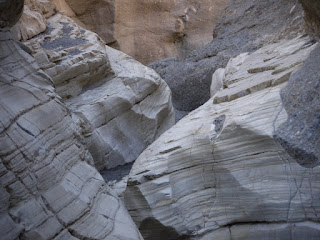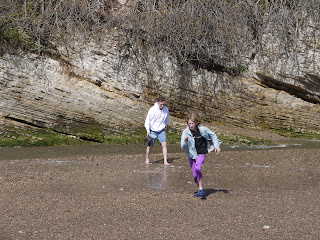Yesterday afternoon we went back to the sand dunes on Mesquite Flats, near Stovepipe Wells. It was a bit windy, which had obviously put people off because it was much quieter than the last time we’d visited. We walked out to the largest sand dune – according to the Park Service, over 700 feet high. Hubby and the kids walked across the top of the sand dune, a dramatic curve, while I remained on a peak below to take photos. Just like everything else in this area, the scale and colors were amazing. We spent about an hour and a half walking out and back, a distance of about two and a half miles. Going up and down the dunes, up and down, it was pretty good exercise for the old calf muscles.
Overnight it rained a bit. Not enough to make the campground significantly damp, but enough to wake up Deep Thought at 5:00am with the drops drumming on the roof of the cab. There was also a bit of additional dampness inside the tin can: Little Starlet peed in her bed for the second time on this trip. We couldn’t remedy the situation with her still asleep this time, but she is claiming that she had no recollection of us getting her up, fixing her bed, going to the toilet etc. I think the poor little thing was very tired again.

In the morning we saw another road runner scurrying over the sand in front of the RV. (This is the only photo we succeeded in taking of one.) They’re cute. We haven’t seen much other wildlife in Death Valley. A couple of little lizards, ravens at the campsite, hardly any insects (though we did see big black beetles at the sand dunes), an antelope ground squirrel, and we heard the coyotes yapping in the darkness.
We drove away from Death Valley along highway 190. At Death Valley Junction – a sad, derelict community steps away from becoming a ghost town – we turned south on highway 127.

This straight road took us through the bottom end of Death Valley and into Silurian Valley, back into the Mojave Desert. We didn’t see any Joshua trees in this part of Mojave. We did see some spectacular sand dunes in the distance at Dumont Dunes Natural Preserve. They looked even taller than the ones at Stovepipe Wells. We also passed many dry lakes.
The little town of Shoshone was in fairly good shape, with a health center, gas station, motel, café and several houses in good repair. At Baker, we turned west on interstate 15. Baker was most notable for having “the world’s largest thermometer” at the side of the road. It was a very easy drive from every perspective.

Calico Ghost Town is a few minutes from I-15. The campground at the Town is pleasantly laid out. We are in site A25, which has full hookups. This was essential as we ran out of water in the van this morning. Unfortunately it is incredibly windy. The van is rocking from side to side as the wind whistles through and up the canyons. It’s a whole new experience for us (and makes us very glad we aren’t in a tent). This will be the first evening that Hubby and I do not sit out by a campfire. It is just too darned cold – and we’re not even sure we’d be able to light a fire at all. Hubby tried parking the van to shield the fire pit, but there is simply too much wind for that strategy to work.
So here we sit. Deep Thought is writing something creative on one computer, I am blogging, Little Starlet is reading (and eating chocolate), and Hubby is in the RV shower! When he gets out, we’ll play a game.
Now to reflect on Calico Ghost Town. Calico was founded as a silver mining town in 1881. The boom years continued till the end of the 1890s when the price of silver fell dramatically and the population fell rapidly from its peak of twelve hundred (1887) to three hundred (1893) and down to only ten in 1951. During its active years, over $86 million of silver was extracted from the hills around here. The population also supported twenty-two saloons, a China Town (for washing and laundry), and a red light district. The town fell into decay until 1951 when Walter Knott, the founder of Knott’s Berry Farm near to Los Angele (a theme park precursor to Disneyland), decided to spend a bunch of money purchasing and “restoring” it. He donated the town to the County of Bernardino in 1966.
That’s the history lesson. The town today is basically a middle-grade tourist attraction. The entry fee is included in the camping charge, which was a good thing, or it might have offended Hubby’s Scottish sensibilities. The town consists of two main streets, with a short walk up to a school house, a mine, and a railway. The mine and the railway have separate charges.
The railway takes a short loop around the top of a hill, allowing a view of some derelict miners’ houses built into the rocks. (In its previous life the train hauled materials away from the mines.)
“Maggie’s Mine” is a genuine silver mine. Interestingly for those of us experienced in passing through mining exhibits in the UK, this one allows everyone to stand upright (and they didn’t insist on us wearing safety helmets, which they would have in the UK). It was fairly interesting to walk through the mine for a few minutes, though there was a minimum of interpretation – not even an arrow saying “Look, silver ore here”.
The kids wanted to pan for gold, but that exhibit was closed. We ate lunch in the Calico House Restaurant (burgers) and dessert in the Miners’ Café (ice cream). We also went into all the different shops, of which there were many, all selling the most bizarre things….like teddies with wings, cowboy statues, dream catchers labeled “Not an Indian Product”, a piggy bank dressed flamboyantly in feathers and sparkles, frilly toilet roll covers, scoop-your-own bath salts and, our absolutely favorite thing, a singing deer’s head which opened and closed its mouth and also told jokes. Honestly.
Deep Thought’s rating out of ten: five, because it was strange and it was a bit too touristy. She’d have liked it to look a bit more like a real ghost town. Little Starlet also rates it at five, because the stuff in the stores didn’t seem like it would ever have been in the town when people lived there. Hubby rates it more generously at six because all the effort at Disneyfication hadn’t completely hidden the mining town atmosphere. I’d rate it at seven, because I like the look of the rugged frontier town architecture (some of which was even real and not a 1950s pastiche).






















































